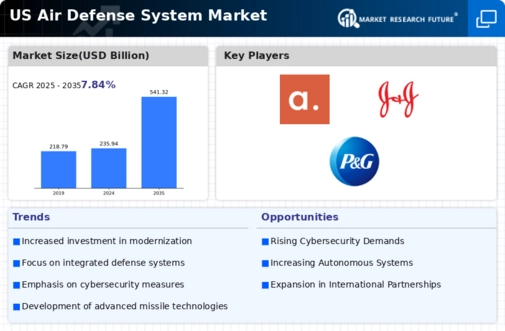Increased Defense Budgets
The air defense system market is benefiting from increased defense budgets across various sectors, including military and national security. The US government has committed to enhancing its military capabilities, with defense spending projected to reach $850 billion in 2025. This financial commitment translates into substantial investments in air defense systems, which are critical for national security. The focus on modernizing existing systems and acquiring new technologies is evident, as the air defense-system market is expected to grow by 10% annually. This trend indicates a strong correlation between defense budgets and market growth, as nations prioritize air defense capabilities in response to evolving threats.
Increasing Geopolitical Tensions
The air defense system market is experiencing growth due to rising geopolitical tensions. This is particularly true in regions where military capabilities are being scrutinized. Nations are investing heavily in advanced air defense systems to counter perceived threats. For instance, the US defense budget for 2025 allocates approximately $20 billion for air defense initiatives, reflecting a strategic pivot towards enhancing national security. This trend indicates a robust demand for sophisticated systems capable of intercepting various aerial threats, including drones and ballistic missiles. As countries prioritize their defense capabilities, the air defense-system market is likely to expand, driven by the need for advanced technology and increased military readiness.
Strategic Alliances and Collaborations
The air defense-system market is increasingly shaped by strategic alliances and collaborations between government entities and private defense contractors. These partnerships facilitate the sharing of resources, expertise, and technology, leading to more effective air defense solutions. In 2025, several key collaborations are expected to emerge, focusing on joint development projects and integrated defense systems. Such alliances not only enhance the capabilities of air defense systems but also streamline procurement processes. The air defense-system market is likely to benefit from these collaborations, as they foster innovation and improve the overall effectiveness of defense strategies.
Technological Advancements in Defense Systems
The air defense-system market is significantly influenced by rapid technological advancements. Innovations in radar systems, missile technology, and command and control systems are reshaping the landscape. The integration of artificial intelligence and machine learning into air defense systems enhances threat detection and response times. In 2025, the market is projected to grow by 15% as these technologies become more prevalent. The US military's investment in next-generation systems, such as the Integrated Air and Missile Defense (IAMD) system, underscores the importance of technological evolution in maintaining air superiority. This driver suggests that ongoing research and development will continue to propel the air defense-system market forward.
Emerging Threats from Unmanned Aerial Vehicles
The proliferation of unmanned aerial vehicles (UAVs) poses a unique challenge to national security, driving demand in the air defense-system market. As UAV technology becomes more accessible, both state and non-state actors are utilizing drones for surveillance and attacks. The US military recognizes this threat and is investing in counter-UAV systems to protect critical infrastructure. In 2025, the market for air defense systems specifically targeting UAVs is expected to grow by 12%. This trend highlights the necessity for advanced detection and interception technologies, indicating that the air defense-system market must adapt to address these emerging threats effectively.














Leave a Comment